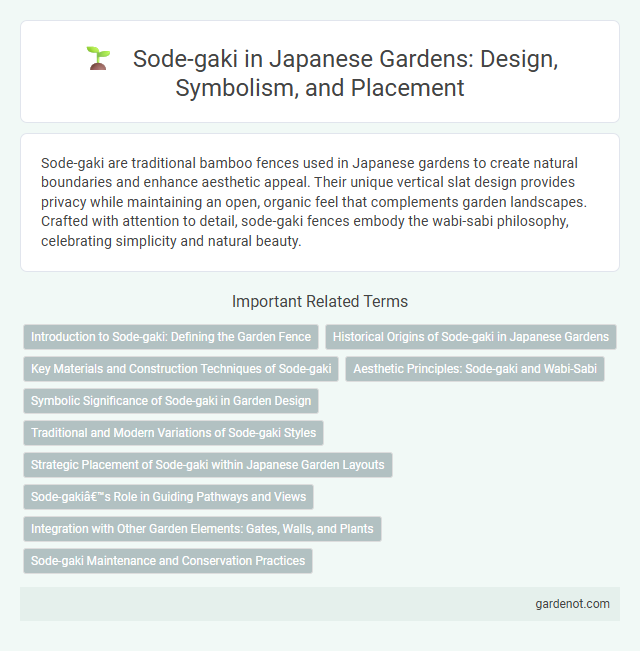Sode-gaki are traditional bamboo fences used in Japanese gardens to create natural boundaries and enhance aesthetic appeal. Their unique vertical slat design provides privacy while maintaining an open, organic feel that complements garden landscapes. Crafted with attention to detail, sode-gaki fences embody the wabi-sabi philosophy, celebrating simplicity and natural beauty.
Introduction to Sode-gaki: Defining the Garden Fence
Sode-gaki is a traditional Japanese garden fence characterized by its woven bamboo or wooden slats designed to create a subtle boundary without obstructing views. This fence style enhances the garden's aesthetic by blending natural materials with minimalist craftsmanship, promoting harmony between enclosure and openness. Sode-gaki serves both functional and ornamental purposes, guiding visitors while maintaining a sense of tranquility within the garden.
Historical Origins of Sode-gaki in Japanese Gardens
Sode-gaki, a traditional Japanese garden element, originated during the Edo period as a practical solution to protect sacred spaces from animals and intruders. Crafted from woven bamboo or wooden slats, this fence type symbolizes subtle boundary-setting without obstructing natural views. Historical records highlight its role in enhancing garden aesthetics while embodying cultural values of simplicity and harmony.
Key Materials and Construction Techniques of Sode-gaki
Sode-gaki, a traditional Japanese garden element, is primarily constructed using bamboo, rope, and wooden stakes to create a natural fence-like structure. The key materials include carefully selected bamboo canes split and tied horizontally and vertically with natural fiber ropes, ensuring durability and aesthetic harmony with the garden environment. Construction techniques emphasize precise knotting methods and spacing to provide both functionality as a windbreak and a refined, understated visual appeal.
Aesthetic Principles: Sode-gaki and Wabi-Sabi
Sode-gaki, a traditional bamboo fence in Japanese gardens, embodies the wabi-sabi aesthetic by emphasizing simplicity, imperfection, and natural beauty. The rustic texture and handmade irregularities of sode-gaki highlight the transient and imperfect qualities valued in wabi-sabi philosophy. This fence style enhances garden spaces by creating a subtle boundary that harmonizes with nature while evoking a sense of quiet elegance and humility.
Symbolic Significance of Sode-gaki in Garden Design
Sode-gaki, or sleeve fences, symbolize modesty and protection in traditional Japanese garden design, subtly guiding visitors while maintaining privacy. Constructed from closely spaced bamboo slats, these fences create harmonious boundaries that blend seamlessly with natural elements, emphasizing wabi-sabi aesthetics. Their understated presence embodies restraint and respect, reinforcing the garden's spiritual and contemplative atmosphere.
Traditional and Modern Variations of Sode-gaki Styles
Sode-gaki, traditionally constructed from bundles of bamboo, serves as a natural fence in Japanese gardens, embodying simplicity and harmony with nature. Modern variations incorporate materials such as metal and synthetic fibers, enhancing durability while maintaining aesthetic appeal and the distinctive woven pattern. These evolving styles balance preservation of cultural heritage with contemporary garden design innovations.
Strategic Placement of Sode-gaki within Japanese Garden Layouts
Sode-gaki, a traditional woven bamboo fence, is strategically placed in Japanese garden layouts to subtly delineate garden zones while enhancing natural aesthetics. Positioned near pathways, water features, or transitional spaces, it guides visitor movement and frames key visual elements without obstructing views. This careful placement balances privacy and openness, reinforcing the garden's harmony and tranquility.
Sode-gaki’s Role in Guiding Pathways and Views
Sode-gaki, traditional Japanese woven bamboo fences, play a crucial role in guiding pathways and framing views within a garden, directing visitors subtly through the landscape. These fences create visual boundaries that enhance the garden's flow while simultaneously highlighting key features such as stone lanterns, water basins, or seasonal plantings. By manipulating sightlines and movement, Sode-gaki contribute to the contemplative and immersive experience characteristic of Japanese garden design.
Integration with Other Garden Elements: Gates, Walls, and Plants
Sode-gaki, a traditional Japanese woven bamboo fence, seamlessly integrates with garden gates, walls, and surrounding plants to create a harmonious boundary that enhances privacy while maintaining aesthetic flow. Its natural texture complements wooden gates and earthen walls, blending effortlessly with moss, shrubs, and koi pond features to support the garden's overall compositional balance. The fence's understated design allows it to function as both a subtle backdrop and a transitional element, enriching the layered spatial experience typical of Japanese garden landscapes.
Sode-gaki Maintenance and Conservation Practices
Sode-gaki hedges in Japanese gardens require regular pruning to maintain their dense, layered structure that symbolizes harmony and resilience. Seasonal trimming ensures healthy growth and preserves the hedge's intricate form, which acts as a natural windbreak and aesthetic boundary. Proper watering and soil aeration prevent root rot, supporting long-term conservation of this traditional garden element.
Sode-gaki Infographic

 gardenot.com
gardenot.com